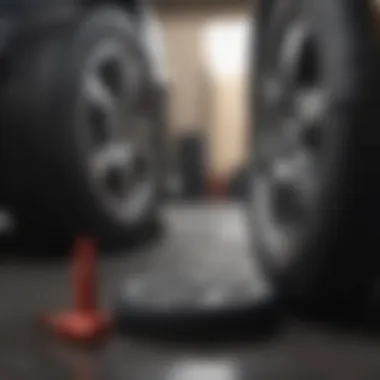Tools and Steps You Need for Changing a Tire


Intro
Changing a tire might seem like a simple task, often tossed around in casual conversations at car meets or among friends. But in reality, it requires the right tools, knowledge, and a step-by-step approach to tackle it effectively. Whether you're a seasoned gearhead or just someone who wants to be prepared for an unexpected roadside predicament, understanding what you need and how to go about it is crucial.
The unpredictability of tire failure can catch anyone off guard. A flat tire can happen while you're heading to work, or during a weekend trip with family and friends. Knowing how to change a tire not only equips you for those moments but also fosters a sense of self-reliance. There’s a certain satisfaction in handling a challenge on your own.
In this article, we will outline the essential tools needed for a tire change, the correct sequence of operations, proper safety precautions, and solid tips for ensuring a smooth experience. Buckle up; this guide aims to make you feel right at home, no matter where the road may lead.
Necessary Tools for Changing a Tire
Having the right tools at your fingertips is crucial when it comes to changing a tire, whether you're dealing with a roadside emergency or merely performing routine maintenance. Without these essentials, even the simplest tire change can turn into a cumbersome task. Knowing the necessary equipment not only simplifies the process, but it also ensures safety and efficiency during the change.
It's not just about raw tools; it's about equipping yourself with knowledge. Understanding how each tool works and its significance in the process can save you from a real pickle when faced with a flat tire. Plus, being prepared with the appropriate gear builds confidence for any driver, ensuring that tire troubles don't derail your plans.
Spare Tire Types
Spare tires come in various forms, each serving a unique purpose. Knowing the differences can guide you toward the best choice for your vehicle.
Full-size Spare
A full-size spare tire is just what it sounds like – a complete match to your regular tires. One of the key characteristics that makes it popular is that it allows you to maintain the same performance and handling as your standard tires.
- Benefits: Using a full-sized spare minimizes the risk of affecting your vehicle's stability during a drive. This type is particularly advantageous for those who frequently travel long distances or in inclement weather.
- Downside: The downside? It takes up significantly more space in your trunk, and it adds weight to your vehicle.
Compact Spare
Compact spares are smaller and lighter compared to their full-size counterparts. Their design allows them to occupy less space and are a common choice in many newer vehicles.
- Characteristics: A typical compact spare might not perform as well as a full-size tire, especially over longer distances. Drivers should expect limitations in terms of speed and distance.
- Advantages and Disadvantages: On the upside, compact spares can be a real space-saver, but you might need to switch back to a standard tire as soon as possible to avoid safety issues.
Run-flat Tires
Run-flat tires have become increasingly popular due to their convenience. The primary feature of this type is their ability to remain usable even after a puncture, allowing you to drive for a limited distance without needing an immediate tire change.
- Key characteristics: The added rigidity in the sidewalls allows these tires to withstand damage and still support the vehicle’s weight.
- Benefits: This characteristic is beneficial for those who want to avoid stopping on dangerous roadways. However, these tires are often pricier and typically need to be replaced rather than repaired.
Jack Options
Choosing the right jack is equally important when it comes to lifting your vehicle for a tire change. Let's take a look at some options.
Scissor Jacks
Scissor jacks are compact and simple in design, making them a common choice for many car manufacturers.
- Key aspect: Their lightweight feature is especially appealing for those looking to keep their emergency kit light.
- Pros and Cons: While scissor jacks are easy to use, their manual operation might not be suitable for everyone, especially for those lacking physical strength or time during an emergency.
Hydraulic Floor Jacks
Hydraulic floor jacks are a heavyweight option designed for stability and efficiency.
- Key characteristic: The hydraulic mechanism allows these jacks to lift heavier vehicles with less effort.
- Benefits: They provide quicker lifts than scissor jacks, but their larger size and weight may not make them suitable for carrying in a car.
Bottle Jacks
Bottle jacks are compact yet capable of lifting substantial weights, making them a versatile choice for various vehicles.
- Key aspect: The upright cylindrical shape allows for easy storage and efficient lifting.
- Advantages and Disadvantages: These jacks tend to be more stable than scissor jacks. However, they can be cumbersome to maneuver, especially if you're in a tight spot.
Lug Wrench Varieties
Having the right lug wrench is pivotal for loosening wheel nuts and ensuring a quick change.
Cross Wrenches
Cross wrenches, also known as four-way wrenches, are a classic choice among drivers.
- Key characteristic: They offer different socket sizes in one tool, making them flexible for various vehicles.
- Usefulness: Their design provides additional leverage, allowing for easier loosening of rusted or tightly-sealed lug nuts.
Telescoping Wrenches
Telescoping wrenches often include a range of sizes and the ability to extend for added leverage.
- Key aspect: The extendable handle allows users to adapt to tight spaces or stubborn lug nuts.
- Pros and Cons: They tend to be more adjustable, but their added complexity might confuse those less familiar with automotive tools.
Power Tools
Power tools come in various forms, with battery-operated impact wrenches gaining a lot of traction.
- Key aspect: Their ability to swiftly remove lug nuts can drastically cut down on time.
- Benefits: Although these tools can be incredibly efficient, not everyone may be carrying a power source in their car kit.


Other Essential Tools
On top of the aforementioned items, you’ll want to have a few more tools handy.
Tire Pressure Gauge
A tire pressure gauge is crucial for maintaining optimal tire performance, even when you're swapping tires.
- Key characteristic: It provides specific pressure readings, ensuring that your tires are in good condition.
- Importance: Running tires at incorrect pressures can lead to blowouts or reduced fuel efficiency.
Flashlight
Having a dependable flashlight can be a lifesaver, especially in low-light scenarios or evenings.
- Key aspect: A good flashlight provides better visibility when you're working on your vehicle.
- Project Importance: Without sufficient light, you could easily overlook critical signals of tire issues; hence, it’s a tool you don’t want to skip.
Gloves
Your hands will be in the midst of dirt and grease during a tire change. Gloves can provide a shield against the mess.
- Key characteristic: Gloves allow for a cleaner and safer working experience.
- Benefits: They give you grip and can prevent cuts or bruises from sharp edges on tires or tools.
In summary, having the proper tools on hand is not just beneficial but essential for effective tire changes. By grasping the characteristics and applications of each tool, you empower yourself with the knowledge to handle any tire-related situation that comes your way.
Preliminary Checks Before Tire Replacement
Before embarking on the journey of changing a tire, it’s crucial to carry out some preliminary checks. These steps not only ensure safety but also streamline the entire process, making it less of a headache. Think of it as setting the stage for a play; a little preparation goes a long way in delivering a flawless performance. Let’s break down the important aspects that set the groundwork for a successful tire change.
Assessing the Damage
Visual Inspection
Carrying out a visual inspection is like taking a first step into the world of tire maintenance. With merely your eyes, you can pick up on potential problems. Look for any noticeable cracks, punctures, or bulges on the tire's surface. These issues can often be spotted before they escalate into something more severe, saving you both time and hassle in the long run.
One key characteristic of visual inspection is its simplicity. Automatic mechanisms aside, you don’t need any fancy gadgets or tools to assess the tire’s condition. Just a keen eye will do the job. However, remember that while visual inspection is a quick way to identify visible flaws, it does have its limitations. It might not uncover underlying issues like internal damage which cannot be seen from the outside.
Identifying Tire Issues
Identifying tire issues digs deeper. It goes beyond just a look and requires observational skills and some basic knowledge about tire functionalities. You might notice uneven wear or recognize peculiar sounds emanating from the tire while driving. These indicators can guide you to specific issues, such as inflation problems or alignment discrepancies.
The core strength of identifying tire issues lies in its proactive approach. Spotting a problem early can lead to corrective actions that prevent more serious complications down the line. However, if misjudged, you might find yourself in a pickle, believing a minor issue is bigger than it is or ignoring something that requires urgent attention.
Choosing a Safe Location
Flat Ground Considerations
Finding a safe, ideally flat ground is non-negotiable when preparing to change a tire. Picture this: you’re on the side of a steep hill. As you lift the vehicle, the chances of it rolling are increased dramatically. Selecting a flat surface significantly reduces these risks and ensures that both you and the vehicle stay stable during the tire change.
A flat ground consideration gives you peace of mind and control over your environment while working. It also minimizes the chances of injury and accidents, which is crucial in roadside scenarios. However, it's worth noting that finding such a location might prove challenging in hurried, real-world situations.
Traffic Safety Measures
Traffic safety measures play a vital role in ensuring that you go about your tire change without any interruptions or accidents from oncoming vehicles. Positioning yourself far enough from traffic and using warning cones or flares can provide an added safety layer. Remember, it's not just about changing that tire but doing so without jeopardizing your safety.
The critical aspect of these measures is awareness of your surroundings. Being vigilant can help you anticipate any potential hazards that might arise while you’re fixated on the task at hand. However, it also demands heightened alertness, with the risk of becoming distracted or forgetting about the surroundings altogether if you’re not careful.
In summary, these preliminary checks are paramount in laying down the groundwork for a tire change. With diligence and a careful approach, the chances of a smooth transition from flat to spare increase significantly. Preparation is the spice of roadside emergencies, and skipping these checks is like baking a cake without flour: it’s bound to fall flat.
Step-by-Step Process of Tire Change
Changing a tire is one of those skills that can save a driver from a pesky roadside emergency. Knowing how to approach this task step by step not only adds convenience but also instills confidence behind the wheel. Every step plays a crucial role, ensuring vehicle safety and facilitating a smooth transition from a flat tire to a functional wheel. It’s not just about swapping out tires; it’s about understanding the process and the importance of each action taken.
Preparation Phase
Preparation is key in any task, and changing a tire is no exception. Getting set up properly ensures that the job can be done efficiently and safely.
Gathering Tools
Before any heavy lifting can start, the first order of business is gathering tools. This aspect is often brushed off as common knowledge but can dictate the entire experience. Having the necessary tools easily at hand can make or break the effort. The standout feature of gathering tools well is efficiency.
Here’s why it’s vital:
- Immediate Availability: When emergencies strike, every second counts. Having tools ready prevents delays and frustration.
- Avoid Missing Items: It’s easy to forget something crucial—like the lug wrench—when rushing. A pre-check list can be a lifesaver.
However, different folks may find certain tools work well for their vehicles, leading to potential disadvantages if the wrong tools are selected.
Removing Hubcaps
The next step is removing hubcaps, often an overlooked aspect yet critical for accessing lug nuts. This step is straightforward but requires care. Many modern vehicles come with hubcaps that click into place and can be tricky to remove without causing damage.


Key characteristics include:
- Accessibility: Making sure the lug nuts can be reached without interference is vital for a smooth tire change.
- Preservation: Taking care not to scuff or break the hubcap helps maintain the vehicle's aesthetic.
Ignoring this step could lead to difficulties when tackling the lug nuts directly, potentially leading to unnecessary complications.
Lifting the Vehicle
Executing the lifting phase correctly is crucial; it makes the subsequent steps manageable and keeps the process safe. Any errors here could lead to dangerous situations.
Positioning the Jack
Getting the jack in the right spot is paramount. The jack needs to be placed under a sturdy section of the vehicle, typically along the frame. Doing this ensures stability as the vehicle is raised, preventing any chances of the jack collapsing.
Benefits of positioning the jack properly include:
- Stability: A well-placed jack offers a solid base, reducing the risks involved in lifting the vehicle.
- Safety: Knowing exactly where to position the jack helps prevent unnecessary damage to the car's undercarriage.
If the jack isn’t positioned correctly, that could lead to a rather shaky situation—quite literally—while working beneath the vehicle.
Raising the Vehicle Safely
Once the jack is properly positioned, lifting the vehicle should be done cautiously. This phase involves steadying the lift and monitoring the vehicle’s stability.
- Smooth Operation: Ensuring the jack is raised slowly contributes to maintaining control.
- Safety Precautions: Keeping hands and limbs clear from the undercarriage prevents unwanted accidents.
Underestimating this step might lead to unsteady lifts, which can escalate to disastrous results.
Removing the Flat Tire
With the vehicle securely lifted, it’s time to tackle the flat tire directly, an aspect that many find straightforward but requires due diligence.
Loosening the Lug Nuts
Before the tire can be removed, the lug nuts need to be loosened. This action has its nuances, as improperly loosened nuts can lead to stripped threads or improper reinstallation later on.
Crucial points include:
- Use of Proper Tooling: Depending on the tool—a manual wrench or power tool—different techniques may apply.
- Cross Pattern Technique: Loosening nuts in a criss-cross pattern helps maintain even tension and prevent wheel warping.
Readiness to face stubborn lug nuts is essential, as they can sometimes be seized tight.
Taking Off the Tire
Once the lug nuts are sufficiently loosened, the tire can be taken off. It's a straightforward motion but can sometimes require a bit of muscle.
Highlights of this step:
- Steady Grip: Having a firm grip on the tire ensures it can be removed neatly without dropping it.
- Awareness of Surroundings: Keeping the workspace clear helps avoid accidents when lifting or shifting the old tire.
Neglecting this phase could lead to further complications, especially if the tire is heavier or more awkward than expected.
Attaching the Spare Tire
After efficiently removing the flat tire, it's time to put the spare one on—an action that completes half of the task.
Aligning the Spare
Aligning the spare tire correctly with the wheel hub is another crucial step. It’s essential for ensuring that the tire sits straight and maintains balance while driving.
Key features:
- Precise Handling: Aligning properly means the lug holes line up accurately, saving time and preventing functionality issues.
- Vibrational Stability: Correct alignment helps avoid vibrations which can be annoying and dangerous while driving.
Failure in this step can lead to compromised driving safety.
Tightening Lug Nuts
With the spare in place, the next point of focus is tightening the lug nuts. Setting these firmly means the spare will stay in place during use.
This entails:
- Cross Tightening the Nuts: Much like loosening, using a criss-cross method ensures even tension is applied.
- Torque Specifications: Knowing the right amount of tightness to achieve helps avoids overtightening, which can warp the wheel.
Not monitoring the tightness could lead to loose wheels, something no driver wants.
Lowering the Vehicle
The final phase of changing a tire involves bringing the vehicle back down to the ground and ensuring everything is secure.


Slowly Lowering the Jack
Lowering the vehicle shouldn't happen in a rush. This phase must be handled delicately to prevent sudden movements that could cause problems.
Characteristics include:
- Gradual Lowering: This control allows for flawless settling back to the ground.
- Constant Monitoring: Watching the vehicle as it descends ensures it�’s balanced and upright.
Speeding through this phase could risk the jack's mechanism or, worse, the safety of those nearby.
Final Tightening of Lug Nuts
Once the vehicle is down, the last task is to perform a final tightening of the lug nuts. Even after initial tightening, revisiting this step ensures all is secure.
Benefits here:
- Safety Assurance: This gives peace of mind that everything is indeed tied down properly.
- Prevention of Movement: Ensuring nothing rattles loose during travel keeps future troubles at bay.
Forgetting this step might result in loose attachments and unwanted expenses down the road.
Post-Change Procedures
After changing a tire, it's easy to feel a sense of accomplishment and relief. But it's not over just yet. The post-change procedures serve a critical role in ensuring that the new tire is functioning properly and that everything is safely packed up. This section emphasizes the importance of taking the time to conduct a few essential checks and properly store your equipment after the tire change. Neglecting these steps can lead to unsafe driving conditions or losing valuable tools that can be crucial for future emergencies.
Testing the Spare Tire
Once the spare tire is attached, it's wise to test it before hitting the road. Testing is not just a good measure; it can prevent potential mishaps down the line.
Check Tire Pressure
Checking the tire pressure is vital. Driving on a spare tire that is under-inflated can lead to uneven wear and could compromise safety on the road. The general rule of thumb is that spare tires typically require a higher pressure than standard tires.
- A notable aspect is that many drivers overlook this simple but effective step.
- The key characteristic of checking the tire pressure is the peace of mind it brings. It functions as a protective layer between you and unexpected breakdowns.
- One unique feature of maintaining optimal tire pressure is that it prolongs the lifespan of the tire, which is a money-saver in the long run.
On the flip side, an overinflated tire can also be dangerous, making it critical to have a reliable pressure gauge on hand for accurate measurement.
Examine for Vibration
After confirming the tire pressure, examining for vibrations is another key step. A spare tire can easily cause irregularities in your vehicle's handling if it isn't seated properly or if there are any balance issues.
- The unique point here is the ability to catch potential road problems before they escalate into serious safety issues.
- The defining characteristic of checking for vibrations is its preventive nature. It's about avoiding future headaches, both financially and in terms of safety.
- A test drive that includes a careful observation of vibrations can be incredibly revealing.
Should you feel any unusual vibrations, it’s advisable to pull over and reassess your installation. Ignoring such symptoms could lead to greater trouble later on.
Storing Equipment Properly
With the work done and the spare tire tested, it’s time to neatly pack everything away. Proper storage is just as crucial as the tire-changing process itself. It can make an enormous difference when an unexpected situation arises in the future.
Organizing Tools
Tool organization keeps everything on hand for future needs. Not having to scramble through a messy bag can save precious time in an emergency situation.
- A key characteristic of organizing tools is efficiency. It enables you to quickly grab your items without digging around.
- This practice also encourages regular checks on your equipment, ensuring no tools are lost or damaged.
- Notably, a well-organized toolkit can make the act of changing a tire less daunting for newcomers.
When tools are easy to access, you might even find yourself better prepared for road trips or weekend getaways.
Plan for Flat Tire Disposal
Lastly, considering how to dispose of the flat tire is crucial. Improper disposal could lead to environmental harm, and many places have strict regulations regarding tire waste.
- A significant characteristic of having a disposal plan is that it demonstrates responsible ownership.
- Setting aside time to plan for tire disposal isn’t just beneficial for you; it also positively impacts the community.
- The unique feature of adopting sustainable disposal methods contributes to eco-friendliness while alleviating potential legal issues.
Whether you choose to recycle your tire or take it to a designated disposal facility, having a plan in place allows you to do the right thing without hassle. It’s one less worry on your list, freeing up mental space for more pressing matters.
Maintenance and Prevention Tips
Maintaining your tires is crucial for both safety and performance. Tires take a beating on the road, and it’s vital to keep an eye on their condition. This section will delve into the steps you can take to prolong tire life and ensure safe driving.
Regular care can prevent a blowout or wear that could compromise handling on your vehicle. Simple checks and upkeep save not only money but also potential accidents, which is well worth the effort.
Regular Tire Inspections
Monitoring Tread Depth
Monitoring tread depth is about more than just seeing how deep the grooves are. It indicates how well tires can grip the road, especially in wet conditions. As the tread wears down, traction decreases, which can lead to hydroplaning in rain and longer stopping distances. A key method for checking this is the penny test: insert a penny into the tread with Lincoln's head facing down. If you can see all of Lincoln's head, it's time to consider new tires. This method is popular because it uses a common item and gives a quick insight.
While there are more advanced tools for measuring tread depth, such as tread depth gauges, the penny test is straightforward and effective. Always remember to check all four tires, as they may wear unevenly depending on alignment.
Checking for Wear and Damage
Checking for wear and damage is crucial to maintaining tire safety. In addition to depth, look for cracks, bulges, or foreign objects lodging into the rubber. These signs can indicate severe underlying issues. The key characteristic here is being proactive. Noticing minor defects can prevent more significant injuries later. This approach works well because it allows for early intervention, potentially saving costs on replacements or extensive repairs. Keep in mind that regular inspection demands little time, yet its benefits can make a substantial difference.
When to Replace Tires
Understanding Tire Lifespan
Understanding tire lifespan means being aware that tires do not last indefinitely. Generally, tires should be replaced every six years, regardless of tread depth, although this can vary based on many factors such as driving habits and climate.
Knowing this helps drivers avoid being surprised by premature tire failure. That’s just no good; you should check manufacturers' guidelines for specific tires. Many tires have wear indicators, small raised bars within the tread, which also serve as guiding markers for replacement.
Understanding this concept is vital; neglecting it can lead to dangerous conditions on the road since aged tires are more prone to failure.
Recognizing Ineffective Repairs
Recognizing ineffective repairs can be a lifesaver. If a tire has been patched up, it's crucial to monitor it closely. Not every puncture can be repaired effectively. For example, if damage is extensively severe, like in the sidewall area, that tire likely should be replaced rather than fixed. Being able to identify when a repair hasn’t been successful can prevent riding on a compromised tire, which is a recipe for potential disaster.
This awareness becomes particularly vital during routine checks. The unique feature here is being able to anticipate future issues rather than just addressing the present ones. Tire shops sometimes miss subtle signs of damage, hence the importance of a second assessment. Keep a keen eye; it pays off.















